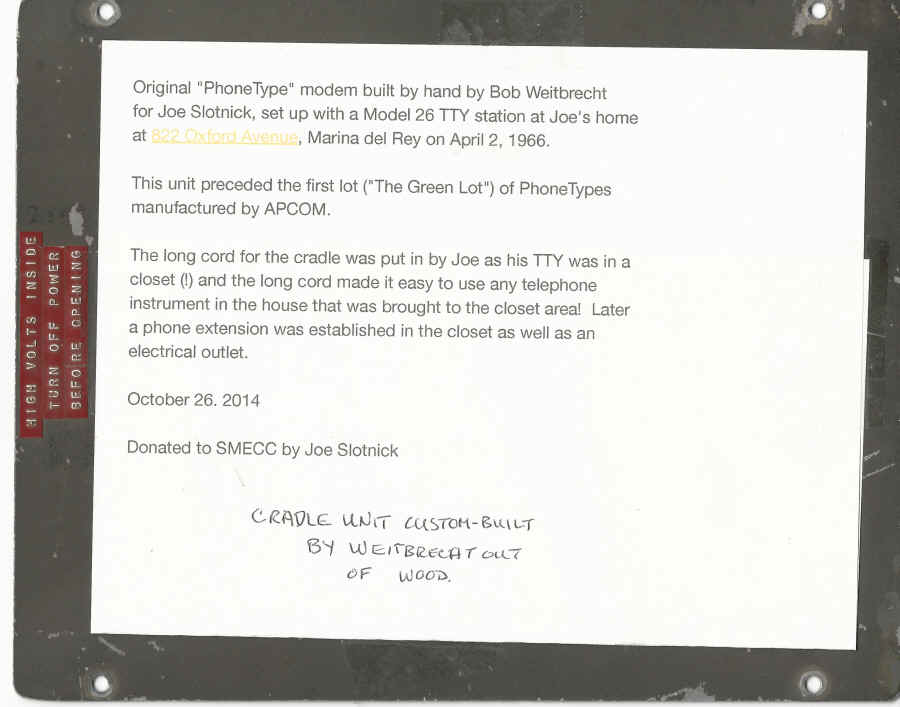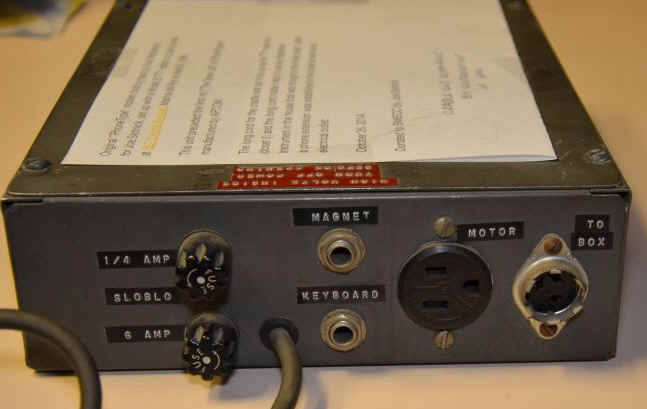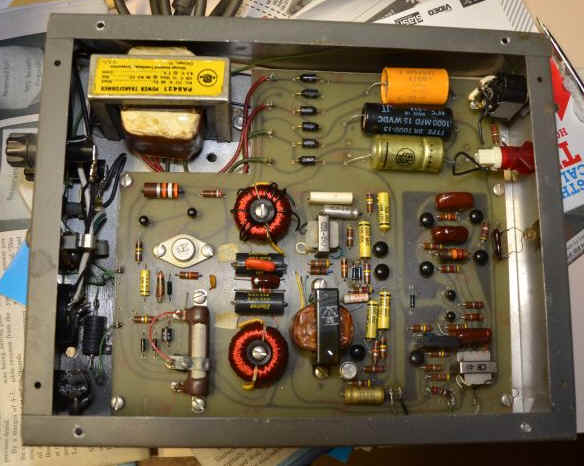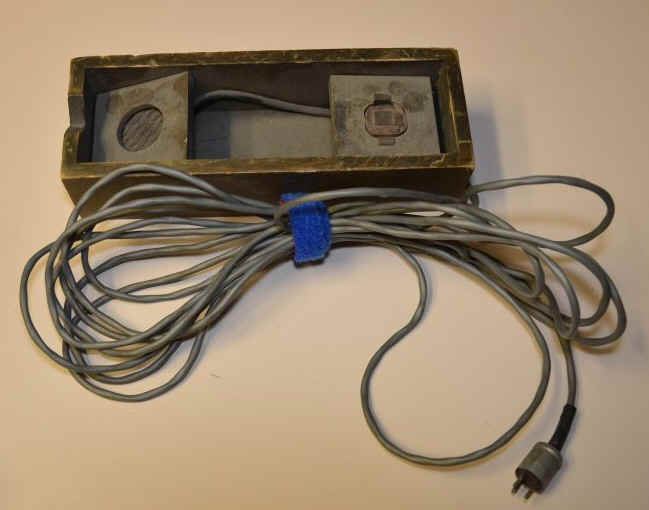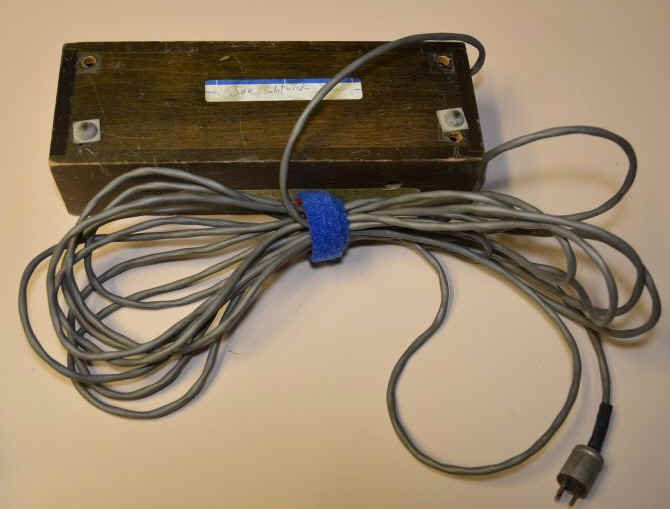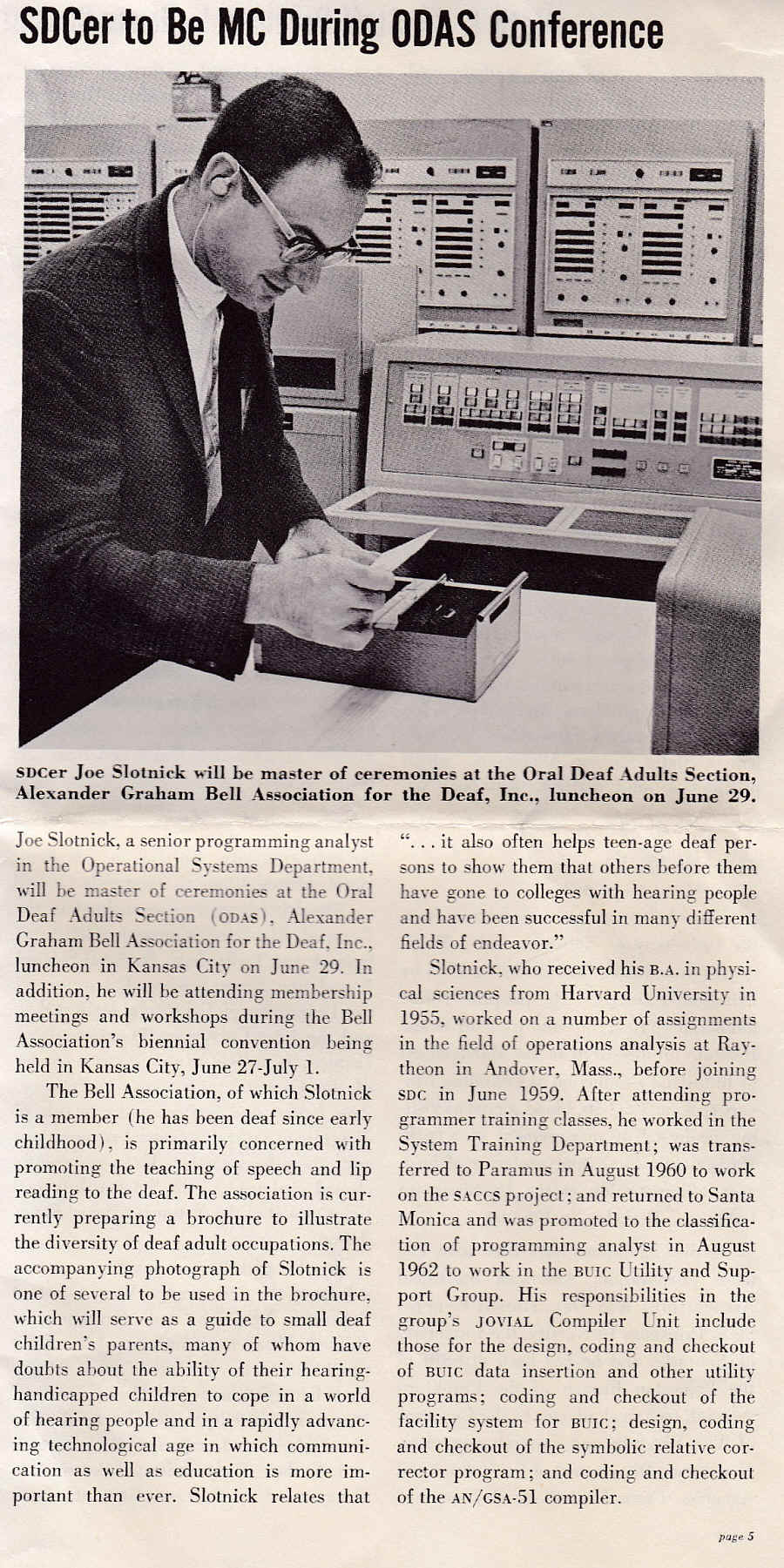
Joe Slotnic tells us "We
finally found the picture I had wanted to send to you,
regarding the story of my interview with SDC and obtaining
employment with them. The date was probably April, 1966,
as the article speaks about me being MC at a luncheon at
the A. G.Bell Convention in Kansas City in 1966. I was a
young 31 years old at that time!"
It was by System Development Corporation and the ad was
looking for computer programmer trainees who could satisfy 5
criteria for employment... I do not remember all 5 criteria
but one of them was "US Citizenship required," and
another was "a suitable mathematical background."
I knew I could satisfy all of them so I took the ad with me
to work the next day, Monday. The ad said that interviews
would be lined up just for two days, Monday and Tuesday. Use
of the telephone (via TTYs and later use of relay services)
was not available for deaf people at that time, that was why
I took the ad with me to work on Monday. (I was working for
Raytheon Manufacturing Corp, and had been working for them
three years. I had started out as a layout draftsman,
pledging with them that I wished to go to night school and
take courses in mechanical engineering. The guy who
recruited me apparently had other ideas for me and hoped I
would become part of an "operations research"
group he was planning to start at Raytheon. To make a long
story short, things did not work out and I ended up being
just a clerical person doing essentially payroll type work.
I had my degree in Physical Sciences that I got from Harvard
in June 1955 and had graduated with nary an idea of what the
heck I wanted to do with my life!) I had our secretary (she
certainly was a great gal and a very cute one too) call the
recruiter for me. She worked hard on him, telling him that I
was a very personable and capable person and that he should
at least give me a chance to come in person and talk with
him. He finally consented to see me at 8am the next morning,
on Tuesday.
There was an ad in the Boston Sunday Globe newspaper
that my first wife noticed (!) and asked me what I thought
about it?
My admiration for the SDC people and working with them was very high
indeed. I remember one quiz where I had the wrong answer for a
question, so I took it up with the instructor. He showed me why I was
wrong, but I asked him to wait, fetched the notebook from the guy I
was taking notes from and pointed out where I got my information. It
turned out that this guy doing the notes was in error himself, but he
had the right answer on his test paper! This gave the instructor a
glimpse into some of my problems - getting the wrong information by
accident and through no fault of my own! They did me a great favor in
assigning me to the Research & Development Dept with programming
work on the "new" IBM 709 computer! Most of the others in
the class were assigned to further work in SAGE. The reason for this,
they said, was that if I had been assigned to advanced SAGE
development with all its needs for instant communications etc I might
not have liked it very much, but doing work either by myself or with a
few others in the 709 environment would be more beneficial for me.
I left SDC 21 years later with quite different feelings. The company
had changed and so had the people within it. It was time for me to
leave, any way. But I had a great 21 years experience with the
company!
Joe Slotnick, SDC Employee #4081.
Added note - And yes I was first deaf programmer at SDC but not first
deaf employee. A deaf girl in Personnel Dept contacted me when she saw
my picture etc in that SDC publication and had been there up to one year
before I joined the company. She was contemplating taking the
programming course and become a programmer. Don't know if she did that
nor do I remember her name!
Joe Slotnick meets Jim Marsters, Bob Weitbrecht and Andy Saks - and the TTY!
Ed, no I have no pictures of my old M26 machine attached to the old
PhoneType. I used it continuously in my house at 822 Oxford Ave,
Marina del Rey, CA until I moved out of it in spring of 1982. With
new lady friend Mary Robinson (we married on Nov 5, 1983) I moved into
this house we live in (been here 32 years!) and she would have no truck
with a noisy TTY in the house (my first wife is a deaf lady). So I
guess that PhoneType was never used again after then.
(Both my M26 machines were the full regalia - table with special paper
roll hanger and the machine - and I had a third unit without table I
used for spare parts. Heaven knows where they are today, sorry.)
Original "PhoneType" modem built by hand by Bob Weitbrecht
__ The Talk Below was delivered by JOSEPH S. SLOTNICK February 6, 1969 at 11:00 A.M. ___
THE TELEPHONE-TELEPRINTER SYSTEM: ITS HISTORY. DEVELOPMENT AND IMPLICATIONSLeadership Training Program in the Area of the Deaf; San Fernando Valley State College. February 6, 1969 at 11:00 A.M.
My talk today covers the telephone-teleprinter system that was developed by deaf people for use mainly by deaf people. 11anyof you here may have seen or heard of this system, and some of you have actually had experience with the system, from a user-only orientation all the way to involvement in procuring, servicing and installing teleprinter machines with the enabling electronic "black box." This story begins in 1963. Actually, it really goes back long before that,say about 20 years ago, when Robert H. Weitbrecht, an exceptionally brilliant deaf man, became interested in ham radio operat ions and took up radio teletypecommunications as a hobby. Mr. Weitbrecht has a Bachelor's degree from the University of California at Berkeley, and a Master's degree from the University of Chicago, both in Astronomy. Astronomy is still a great interest in life for Mr. vleitbrecht, but his present position is as a research physicist ~-1ithStanfordResearch Institute, Menlo Park, in its Communications Laboratories . His workinvolves research into and development of quite sophisticated electronics equipment for SRI's customers, which include the united States Air Force, Lick Observatory, and others.
Such is the background of this story as i t leads to 1963, when Dr. James C.Marsters of Pasadena met Hr. Weitbrech t. Dr. Marsters is a deaf man, a respectedorthodontist who has a successful practice. He has had a continuing interest in communication aids for deaf people. He has been involved in the making and selling baby-cry alarms, vibrating alarm clocks, telephone speech indicators and other such gadgets, electronic or otherwise, that he felt would help deaf people in their . .everyday lives. You can imagine the electric shock of Dr. Marsters' meeting Mr. Weitbrecht.
Let us now examine other modes of using the telephone that have been developed and that would hold particular interest for the deaf person. I am speaking here about deaf-to-deaf communications methods; this necessarily pr ecludes discussion of the speech indicator which is a very valuable tool fordeaf people in those deaf-to-hearing situations involving use of the telephone.First, there is the Electro-Writer. The Electro-Writer, I have been told, has been around - not five, not ten nor twenty years - but ninety years~ It is a marvelous instrument, but let us look at the cost factor. Rental of special telephone lines run to about fifty dollars a month, and the Electro-Writer itself must be purchased, at a cost of over one thousand dollars. I do not need to elaborate any further for you to realize the almost total impracticality of the system as far as the average deaf person is concerned. Second, there is the Picture-Phone which utilizes broad frequency bands for a television screen. The Picture-Phone also requires special transmission lines. It is still in the experimental stage, and although it is quite possibly the best thing that deaf people could have as far as use of the telephone is concerned, it promises only to be quite expensive if and when it becomes commercially available., , 2 Suffice it to say here that both Dr. Marsters and Mr. Weitbrecht knew that waiting for such developments to come will be ,just that - waiting. Marstersasked Weitbrecht about the feasibility of devising Some kind of interface between a teleprinter and the telephone that would be analogous to the interface between a teleprinter and the short-wave radio as is used in RTTY - radio teletype - communications. After much discussion, three men - Dr. Marsters, Mr. Weitbrecht, and Mr. Andrew Saks (the last named is a deaf businessman) - set up the R. H. Weitbrecht Company to design and develop such an interface between the teleprinter and the telephone.
Mr. Weitbrecht's scheme (as far as my non-professional mind can understand it) involves converting teleprinter impulses at the transmitting end into sound intervals which are then sent over the telephone lines, and the conversion at the receiving end of those sound inte rvals back into teleprinter impulses. Theteleprinters now commercially available are capable of great speeds and sophisti- .cation, but Weitbrecht confined himself to the 5-level code and 60 words-per-minutecapability of most of the old teleprin ters used by both Western Unionand the American Telephone and Te legraph and associated companies. (I understandthat, with some modifications, the PHONETYPE can be adapted for faster speeds and higher-level codes.) Most of the old teleprinters being phased out of operations are of the 5-level code, GO words-per-minute variety; these were feltto be the best for the use of deaf people as they are available for very low cost, if not for free.
From 1964 through 1965 a systematic debugging and xedes tgn program wascarried out. The initial PHONETYPES (we called them terminal units in those days) were distributed and installed in strategic locations in the United States to help with the working out of the different lines and circuits problem mentioned previously. I am proud to say I was a small part of this development. Calls were made everywhere at different times; now ~1ehave a finished product that is truly The biggest problem that had to be overcome w as to make a unit that wouldwork reliably over the many different telephone circuits and lines throughout the United States. No help was forthcoming from the telephone companies themselves. There are, you see, about 2,000 different independent telephone companies in the country, and not all of them are part of the nationwide Bell Telephone system. For example, right here in the Southern Califo rnia area we have two quite largetelephone companies, the Pacific Telephone Company which is part of the Bell System, and the General Telephone Company. I know there are other telephone companies in this area, but the only one I have heard of directly so far is the One out in the Mission Hills-Granada Hills area which is called the California. Water and Telephone Company!
In June, 1964, at the bien nial convention of the Alexander Graham BellAssociation for the Deaf in Salt Lake City, the three men of the R.H. Weitbrecht Company demonstrated a prototype telephone-teleprinter system. It was witnessed by the participants of the convention, among them the twenty people (deaf) whowere then forming the Oral Deaf Adults Section of the Bell Association. Also on hand to observe was the just-elected president of the National Association of the Deaf, Hr. Robert Sanderson.
3 a marvel of electronic engineering and development. The name PHONETYPE is a registered trademark, and the PHONETYPE circuit has a patent pending, These PHONETYPES have overcome a problem that had forced the Bell System to develop its TELEX system, using special lines for transmitting teleprinter signals, and the Western Union its TWX system.
The development of the PHONETYPE has cost tens of thousands of dollars. It is safe to say that the three men who put their money and their faith into the development of the system do not have much hope of recovering very much of their investment. Yet today, in the wake of the success and the acceptance of the PHONETYPE, they are involved with research and development of other high-quality aids for communication uses by deaf people.
The Applied Communications Corporation was formed and chartered by these same men for liability purposes. This name and that of the R.H. Weitbrecht Company are practically synonymous, but it is the Applied Communications Corporation name that you see on the PHONETYPES. and their other products.
There are now several hundred PHONETYPE stations across the country, including some in the Federal government and in schools for the deaf, as well as here in SFVSC. The number is growing fast; the growth is limited only by the number of available surplus teleprinters and volunteers to pick them up, service them, and install them. Both the Western Union and the American Telephone and Telegraph Company have been very generous in donating to the system surplus teleprinters as they become available. The cost to the final "customer" is but the cost of the PHONETYPE, and a nominal fee charged to help with the procurement, servicing and installation of the teleprinters. Of course, a requisite for the "customer" is regular telephone' service in his place of residence.
The Teletypewriters for the Deaf, Inc. group was formed as a cooperativeventure between people in the Oral Deaf Adults Section of the Bell Association and the people in the National Association of the Deaf to aid in the work involved in ferreting out sources of surplus teleprinters and picking them up. servicing them and installing them. There are 6 representatives of the TD, Inc. here in the Los Angeles metropolitan area, coordinated by Dr. Marsters. In St . Louis there has been a phenomenal growth of the teleprinter system.It began when Paul Taylor, a deaf engineer then with McDonnel Douglas Corp. as a reconnaissance engineer, got a direct line with two teleprinters between his house and that of his in-laws. He found out about the PHONETYPE system, and was instru~ mental in "selling" the idea to his deaf friends. There are now approximately 60 stations in St. Louis, and they even have formed their own answering service~ For a fee they have hired a hearing person to be their "ears," equipped him with a PHOHETYPE and a teleprinter. You see, professional answering , services are ratherexpensive. Yet we have two instances of use of professional services, one here in Pasadena and the other up in Menlo Park.
What are the implications of such wide-spread use of these teleprinters with the aid of PHONETYPES? We all know that the writteword is a powerful aid
4 in the development of language, and it is encouraging to note that deaf people, using the teleprinters, have picked up langu age patterns of their friends as theytalk away on the machines! Deaf people can now call other deaf people; this saves "bothering" heir hearing neighbors and friends. Deaf people can call other people, whether deaf or riot, who are similarly equipped, and have the hearing people on the other end relay their messages to hearing people such as doctors, dentists, employment agencies, etc. You can imagine the use and the value of the system for emergencies!
Deaf people now have a powerful tool with which they may communicate with each. other, and indirectly, with hearing people. We can all be proud of the fact that the creative genius of man is such that a deaf person, with a wonderful electronics background, and with help and encouragement, can come up with a product that is of everlastingly great use for his fellow deaf friends.
JOSEPH S. SLOTNICK ed-2/14/69 ,r
|
